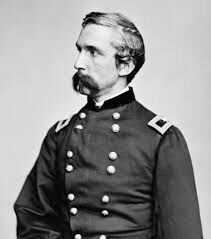Psychology
Mortality Salience During a Pandemic
Lessons from military psychology.
Posted September 4, 2020
When thinking about the psychological impact of war on soldiers, one of my favorite quotes comes from Joshua Lawrence Chamberlain. Chamberlain’s actions at Little Round Top during the Battle of Gettysburg were instrumental in the Union Army’s ultimate victory in that engagement. For his gallantry in action at Little Round Top, Chamberlain was awarded the Medal of Honor. After the war, he went on to serve as the Governor of Maine and later as President of Bowdoin College. Later in his life, reflecting on his combat experiences, Chamberlain wrote, “War is for the participants a test of character: It makes bad men worse and good men better.”[i]

Chamberlain’s notion that war can affect its participants in either a negative or a positive way is supported by military psychology research. On the negative side, some combatants experience significant negative reactions, including post-traumatic stress disorder, depression, anxiety, substance abuse, or an erosion of their personal conduct. On the positive side, a greater number display resilience in the face of the adversity of war, and some even experience personal growth.
The latter trajectory, referred to as post-traumatic growth, is characterized by an enhancement of positive personal attributes, such as the capacity to love, gratitude, courage, and integrity.[ii] Medal of Honor recipients, singled out for the most heroic of actions, display high levels of the positive character attributes of self-regulation, leadership, persistence (grit), teamwork, and, more than anything else, a genuine sense of humility and selfless service.[iii]
In a previous blog, I wrote about the parallels between the COVID-19 pandemic and war. There are many similarities. The U.S. Army uses the acronym VUCA—volatile, uncertain, complex, and ambiguous—to characterize war. The VUCA concept is equally descriptive of the pandemic. The virus waxes and wanes, its course is difficult to predict, solutions to contain it are complex, and the best approach to combating it is unclear. But unlike war, which directly impacts only combatants and those civilians in the combat zone, the pandemic affects everyone. That is to say, we share a common experience of a VUCA situation, and, as Chamberlain observes, some of us will end up the worse for it and others better.
War also increases mortality salience, a concept derived from terror management theory.[iv] Soldiers facing battle know that they may be killed or severely wounded. We all know that ultimately death awaits us, but for soldiers, this sense is tangible and immediate, not something that may happen in the distant and vague future.
With the pandemic, mortality salience is raised for everyone. Some choose to deny or ignore it, but the threat is real. At the time of this writing, over 180,000 Americans have died of COVID-19 in just a six-month period. By comparison, from 1964 to 1975—an 11-year period—56,297 American soldiers were killed in Vietnam. From 1950 to 1953, another 33,686 Americans were killed in the Korean War. Thus, in just six months, the pandemic has claimed about twice the number of American lives as the combined total of the Korean and Vietnam Wars, and in only a small fraction of the time. Volatile, uncertain, complex, and ambiguous, indeed. And deadly!
The effects of increased mortality salience vary and are dependent on a number of psychological variables, including self-esteem and religiosity. Increases in mortality salience may have a variety of behavioral and attitudinal effects, including an increase in risk-taking behavior and enhanced adherence to cultural norms and values. It is interesting to look at the behavior of Americans during the pandemic from a mortality salience lens. We see reports of increases in anti-social behavior, such as people who get into arguments or even violent encounters with others when asked to wear a mask in public. There are almost daily media reports of increases in anxiety and other pathologic responses to stress. A New York Times article reports that alcohol use has increased, especially among those who drank heavily prior to the pandemic and those at risk for problem drinking.[v]
We also see positive, prosocial behaviors during the pandemic. Volunteers step up to help food banks distribute food to those in need. Donations to some charities increase. A Survey Sparrow report suggests eight positive consequences to the pandemic, including building and enhancing close personal relationships.[vi]
People may feel more grateful for the good things they still have.[vii] Anecdotally, we see neighbors interacting more than usual, and children playing together in ways reminiscent of previous generations, riding bikes together, or just hanging out. In short, many, and perhaps most, people make adjustments to their behaviors and attitudes to accommodate the “new normal” of the pandemic.
While it is troubling to dichotomize people into the two categories of “good” or “bad,” Chamberlain’s essential point that adversity affects individuals differently is well taken. One can consider four trajectories of adversity—pathology, invulnerability, resilience, and personal growth. Military psychology shows that in combat—one of the most traumatic and adverse situations imaginable—pathology is by far the least common trajectory.[viii] Most combatants emerge from their experiences unchanged or stronger over the long run. This provides encouragement for us all as we continue to deal with the VUCA conditions of the pandemic.
So how do we optimize the “good” outcomes to the pandemic and mitigate against the “bad” outcomes? There is no simple answer, but studies of soldiers suggest that cultivating and strengthening positive character traits, embracing and reinforcing relationships with family and friends, actively seeking meaning and purpose in life, and maintaining good sleep, exercise, and nutrition help. Organizations may optimize good outcomes by establishing and maintaining a positive organizational climate and reminding managers and leaders that caring for the needs of individual members is of the utmost importance, especially during a crisis.
Preparing for the inevitable adversities of life by doing these things before the “bang” is more effective than reacting to them afterward. There is a two-way street between mental and emotional health and adversity. Trauma and adversity may indeed trigger negative reactions, as Chamberlain implied. But a strong foundation of mental and emotional health may also prevent or lessen the impact of trauma and adversity or allow for personal growth when it does occur. Continually nurturing our psychological well-being, therefore, is of fundamental importance in determining who will respond poorly or favorably to life’s challenges.
Note: The views expressed herein are those of the author and do not reflect the position of the United States Military Academy, the Department of the Army, or the Department of Defense.
References
[i] Joshua Lawrence Chamberlain, The Passing of Armies: An Account of the Final Campaign of the Army of the Potomac (New York: G. P. Putnam’s Sons, 1915), 295. Note that Chamberlain’s remarks were published in 1915. I am confident that today he would have used gender inclusive language.
[ii] Michael D. Matthews, “Tough Hearts: Building Resilient Soldiers,” in Head Strong: How Psychology is Revolutionizing War (Revised and Expanded Edition). New York: Oxford University Press, 2020, 99–122.
[iii] Nansook Park, “Congressional Medal of Honor Recipients: A Positive Psychology Perspective,” paper presented at the Annual Meeting of the American Psychological Association, Washington, DC, August 2005.
[iv] Clay Routledge and Matthew Vess, eds. Handbook of Terror Management Theory. Academic Press, 2018.
[v] Maria Cramer, “Could All Those ‘Quarantinis’ Lead to Drinking Problems?” New York Times, May 26, 2020. https://www.nytimes.com/2020/05/26/health/coronavirus-alcohol-addiction…
[vi] Vipin Thomas, 8 Positive Impacts to look forward to post the COVID-19 pandemic, Survey Sparrow, https://surveysparrow.com/blog/positive-impacts-to-look-forward-to-post…
[vii] Debbie Haski-Leventhal, Seven positive outcomes of COVID-19, The Lighthouse, April 27, 2020, https://lighthouse.mq.edu.au/article/april-2020/seven-positive-outcomes…
[viii] See Chapter 9: “The Crucible of Life Experiences,” in Robert L. Caslen, Jr. and Michael D. Matthews, The Character Edge: Leading and Winning with Integrity (St. Martin’s Press, release date 13 October 2020).




